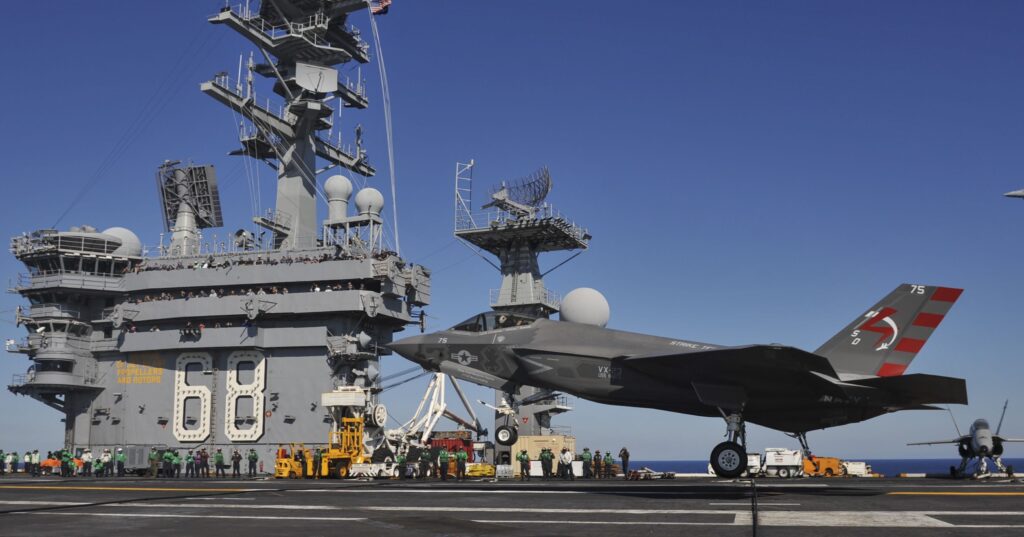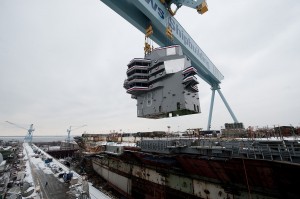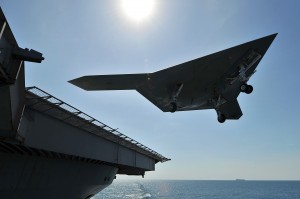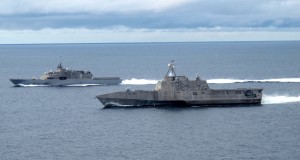
A Navy F-35C conducts its first-ever arrested landing aboard the carrier USS Nimitz
WASHINGTON: The conference version of the defense policy bill for 2016 puts the Navy on notice in multiple high-priority programs. In three areas — carriers, the UCLASS drone, and LCS — Sen. John McCain‘s tough positions prevailed over the House, albeit with some compromises around the edges. In a fourth — Ticonderoga-class cruisers — it was a House leader, Rep. Randy Forbes, who pushed harsher measures and got a partial victory.
The sweating starts tomorrow, when the Navy’s acquisition chief, three admirals, and three other administration officials face Sen. McCain over the notorious overruns on the next-generation aircraft carrier, the Gerald Ford (CVN-78).

The nuclear carrier USS Ford (CVN-78) under construction at Newport News Shipbuilding.
McCain, an old Navy pilot, didn’t get all the language he wanted on the Ford-class carriers. He sought to fence off $100 million for the second ship, the Kennedy (CVN-79), until the Pentagon certified that the class had undergone thorough trials against shock and blast. The conference bill (Section 128) includes his language but also grants the Defense Secretary the power to issue a waiver. Likewise, the Senate bill reduces the maximum allowable cost for Kennedy from $11.5 to $11.4 billion. The conference bill (Sec. 122) includes the lower limit, but adds a waiver option that lets the Navy go back up to $11.5 if cutting costs compromises the ship’s performance.
But Congress has ensured it will keep a very close eye on the Ford class. The conference bill (Sec. 121) includes a strict Senate-designed system of quarterly reports about any changes to Ford that adds at least $5 million to the cost — that’s less than 0.05 percent. The Navy Secretary and Chief of Naval Operations must personally certify the necessity for each change, the bill says. And they can’t leave this to their underlings. They are “precluded from delegating the certification.” The bill also demands a separate, one-time report detailing the Navy’s methodology for calculating inflation on the carriers, a continuing bone of contention with the Hill.

The X-47B drone scoots off the back end of the USS BUSH flight deck and back into the sky after its first “touch and go.”
The other big battle with the Navy is over what flies from the future carriers: specifically, what kind of combat performance should be designed into a drone called UCLASS (Unmanned Carrier-Launched Surveillance & Strike). The Navy favors an armed scout; the Hill a long-range stealth bomber.
The House wanted to approve the Obama administration’s $135 million request for UCLASS, while continuing to press the Navy to change its requirements. The Senate wanted to zero out the existing UCLASS program and add $725 million to new research dn development into carrier-launched drones. The final bill compromised. On the one hand, it not only keeps the UCLASS program alive but more than doubles its budget, to $350 million. On the other, it gives the Navy strict direction to use the money to develop bombers: “penetrating, air-refuelable, UCLASS air vehicles capable of performing a broad range of missions in a non-permissive environment.” The bill also insists the Navy make use of the existing X-47B demonstration drones — basically proto-prototypes — rather than mothballing them to save money.

The two Littoral Combat Ship variants, LCS-1 Freedom (far) and LCS-2 Independence (near).
On the surface of the water floats another favorite target of Congress, the Littoral Combat Ship (LCS). The House agreed to Senate language (Sec. 130) limiting expenditures on the beefed-up second-generation LCS, called a frigate, until the Navy submits detailed justifications of why they chose this particular set of upgrades. The House did get the Senate’s limit dialed down, however: Instead of “fencing” 75 percent of LCS frigate funds until the Navy’s report comes in, the conference only restricts use of 50 percent.
The Senate also succeeded in adding an LCS angle to a House provision on one of Breaking Defense‘s favorite subjects, mine warfare. The House had asked the Navy for a major report next year and an annual “mine countermeasures master plan” thereafter. The Senate had no such provision. The final conference includes the House idea — with a Senate addition that the report must specifically go into both the LCS’s current mine-warfare gear, a target of McCain’s, and alternatives.
All these programs — carriers, UCLASS, LCS — are cases where the Senate pushed harder than the House. But in at least one area, the House had come harder on the Navy, and the Senate got them to ease off. That area was the Ticonderoga-class cruisers, aging Aegis ships that the Navy wants to overhaul.

Cruiser USS Cowpens
The admirals’ original plan had been to scrap seven cruisers, which Congress rejected. But many on the Hill believe the current plan to overhaul them is so slow, and so poorly funded, that it amounts to scrapping in disguise. So, led by the fire-breathing Rep. Randy Forbes, a fierce critic of the administration, the House had passed language required the overhauls to start next year and to proceed on a brisk schedule thereafter.
The final conference bill omits Forbes’s provisions. But the conference report unmistakably endorses his distrust and puts the Navy on notice:
“The lack of fiscal support in the fiscal year 2016 FYDP [future year defense plan for 2016-2020] and previous requests for the early retirement of some of these cruisers has led the conferees to question the administration’s resolve to retain all of these cruisers through the end of their service lives,” the report says. “Continued conferee acceptance of the Navy’s plan will be predicated on the administration’s decision to fully program across the FYDP for manpower, readiness, and modernization for all cruisers.”
This is how Rep. Forbes put it in a statement to Breaking Defense: “The Conference Report reflects my belief that the Navy needs the cruisers and a needs to have a clear plan for to modernize and sustain them that is fully funded across the FYDP. The House and Senate are on record now as expecting the Navy to show in its budgets that it is truly committed to modernizing these critical assets.”
Nothing in this bill forces the Navy to change course on the cruisers. But it definitely lines Congress up for a future collision over the Ticonderogas.
Multi-ship amphib buy could net $900M in savings, say Navy, Marine Corps officials
Lawmakers gave the Navy authorities to ink a multi-ship amphib deal years ago, but the service has not utilized that power yet.


























